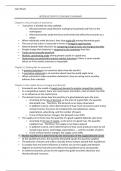Cato Sluyts
INTRODUCTION TO ECONOMICS SUMMARY
Chapter 1; ten principles of economics
• Economics is divided into two subfields:
o Microeconomists study decision making by households and firms in the
marketplace
o Macroeconomists study the forces and trends that affect the economy as a
whole
• When individuals make decisions, they face trade-offs among alternative goals
• The cost of any action is measured in terms of foregone opportunities
• Rational people make decisions by comparing marginal costs and marginal benefits
• People change their behavior in response to the incentives they face
• Trade can be mutually beneficial
• Markets coordinating trade among people usually in a good way
• Government can potentially improve market outcomes if there is some market
failure or if the market outcome is inequitable
Chapter 2; thinking like an economist
• A positive statement is an assertion about how the world is
• A normative statement is an assertion about how the world ought to be
• When economists make normative statements, they are acting more as policy
advisors than scientists
Chapter 3; the market forces of supply and demand
• Economists use the model of supply and demand to analyze competitive markets
• In a competitive market, there are many buyers and sellers, each of whom has little
or no influence on the market price
• The demand curve shows how the quantity of a good depends upon the price
o According to the law of demand, as the price of a good falls, the quantity
demanded rises. Therefore, the demand curve slopes downward
o In addition to price, other determinants of how much consumers want to buy
include income, the prices of complements and substitutes, tastes,
expectations, advertising, and the number of buyers
o If one of these factors changes, the demand curve shifts
• The supply curve shows how the quantity of a good supplied depends upon price
o According to the law of supply, as the price of a good rises, the quantity
supplied rises. Therefore, the supply curve slopes upward
o In addition to price, other determinants of how much producers want to sell
include input prices, technology, expectations, … and the number of sellers
o If one of these factors changes, the supply curve shifts
• Market equilibrium is determined by the intersection of the supply/demand curves
• At the equilibrium price, the quantity demanded equals the quantity supplied
• The behavior of buyers and sellers naturally drives markets toward their equilibrium
• To analyze how any event influences a market, we use the supply and demand
diagram to examine how the event affects the equilibrium price and quantity
• In market economies, prices are the signals that guide economic decisions and
thereby allocate resources




